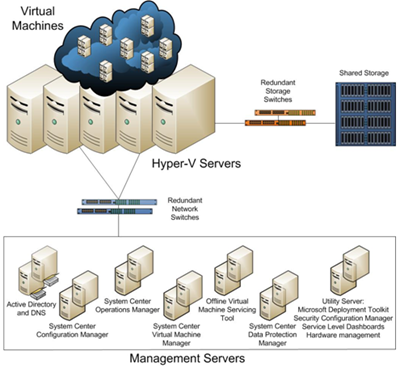Microsoft just published the beta version of a new Infrastructure Planning and Design guide.
Titled Dynamic Data Center, this 43-pages blueprint on what Microsoft defines “a combination of automation, control, and resource management software with a well-defined topology of virtualization, servers, storage, and networking hardware”.
The guide is divided in five main parts:
- Determine the Dynamic Data Center Scope
This part helps to define the scope and determine the workloads that will be included in the Dynamic Data Center project. It’s divided in three steps: - Determine the proposed initial workloads for the Dynamic Data Center.
- Select the workload fault-tolerance approach (including Load Balancing, VM-Level and Host-Level Clustering, as well as Application-Level Fault Tolerance).
- Determine the initial size of the Dynamic Data Center.
- Design the Virtualization Hosts
This part helps to design hosts that meet the capacity, performance, placement, and fault-tolerance requirements of the organization. It’s divided in three steps: - Group the workloads
- Design the host’s Hardware configurations
- Determine host connectivity requirements
- Design the Software Infrastructure
This part helps to design the software infrastructure in a way it can provide directory and authentication services, virtual machine management, configuration management, software distribution/inventory/patch management, event monitoring and collection, remote desktop services and hardware management. - Design the Dynamic Data Center Storage
This part helps to design the storage infrastructure in a way it meets requirements of capacity, performance delivery, fault tolerance and manageability. It’s divided in four steps: - Design the storage system
- Design the host storage connections
- Design the storage switches
- Select the backup approach
- Design the Network Infrastructure
This part helps to design the network infrastructure to accommodate the requirements accumulated throughout previous steps. It’s divided in three steps: - Design network switches
- Design the hardware load balancers
- Design the firewalls
What the guide doesn’t cover instead is:
- Utility service providers or hosting companies offering cloud computing, cloud computing platforms, cloud platform services, or cloud infrastructure services.
- Windows Live™ network of Internet services or other consumer-oriented, cloud services.
- Microsoft Online Services or other third-party software-as-a-service organizations delivering Microsoft infrastructure technologies.
- VM guest planning is a complex topic, and although it informs the scoping in this guide, it is considered a related but separate exercise from planning the Dynamic Data Center infrastructure.
Now, while this document is a good starting point to plan and design what Microsoft calls a dynamic data center, it’s nowhere near the level of completeness that a customer need to design his infrastructure from scratch. And yet, it’s a great way to envision how massive is the investment that any company has to dedicate to data center design.
After reading this document, any customer would recognize some value in the emerging unified/fabric computing trend that companies like Egenera and Cisco are leading.


